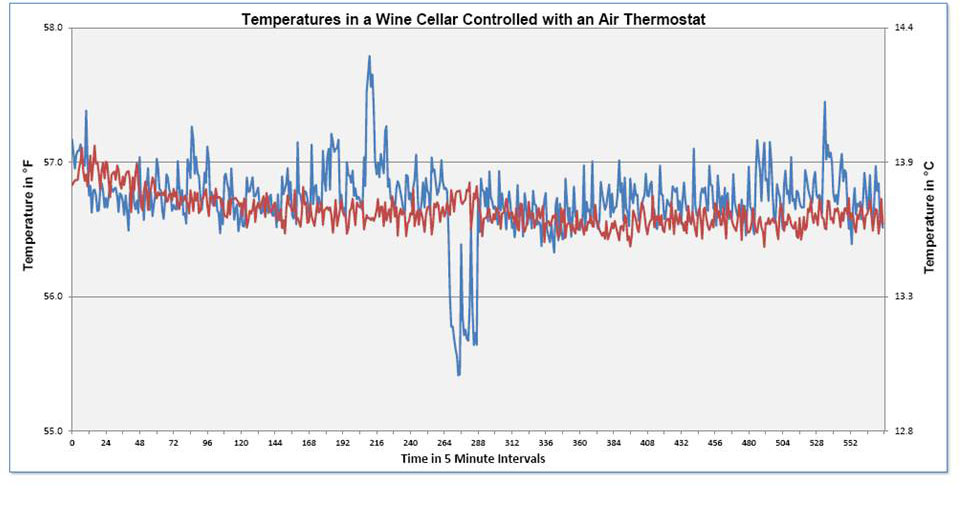Bottle probes are never an effective way to accurately gauge the conditions of your cellar.
When designing your wine cellar, you want to ensure stable wine temperatures for proper preservation and aging of the wine. The vast majority of sensors used to control temperature in wine-cellar air conditioners (irrespective of brand) are accurate to +/- 1°F (0.56°C), but can experience wider fluctuations. Depending on the manufacturer, these sensors can adjust your cellar conditions based on either air temperature or using a bottle probe.
Unfortunately, bottle probes can’t catch the problem until the damage is done!
When the cooling system is controlled (turned on and off) by a sensor located in the liquid of a bottle, the wine itself is subjected to the full temperature swing of the instrument. In other words, if the sensor and controller are rated at +/- 1°F (0.56°C), the wine temperature will change by 2°F (1.12°C) or more with every on/off cycle of the cooling unit. This will stress the wine and can cause degradation in the quality of the wine.
Using an Air-Sensing Thermostat
By sensing the cellar air temperature, even a +/- 1°F (0.56°C) change in the thermostat will cause only a fraction of a degree change in the wine temperature. This is because of the thermal mass inertia of the liquid is essentially insulated inside the glass bottle. Air temperature changes much faster than the liquid temperature since it is lighter and more sensitive to load variations. A good thermostat with a range of +/- 1°F (.56◦C) will keep the wine at basically a constant temperature. [Check out the variety of air-controlled wine cellar environmental control units we offer.]
Here is some data from a wine-cellar controlled using an air thermostat over a 48-hour period. The air temperature varied (min to max) 2.4°F (1.3°C), while the temperature of the wine fluctuated only 0.7°F (0.4°C).

While wine-cellar air conditioning units regulated using air temperature will run more frequently but for shorter periods of time than wine-cellar air conditioners regulated by a bottle probe, this is better for your wine cellar. When wine-cellar air conditioners run for long periods of time, they draw significantly more moisture from the air and subject the wine cellar itself to very wide temperature swings, degrading racking and other cellar elements.
(In case you’re wondering, there should be no significant difference in energy usage based on the type of temperature regulation, if the installed units are equally energy efficient).
Learn more about the remote interface controller and remote sensors we offer here. Up to three remote sensors can be placed throughout the wine room and be connected to one Wine Guardian system. The sensors can continuously monitor temperature & humidity and will alert you if one of those variables fall out of optimal range.

